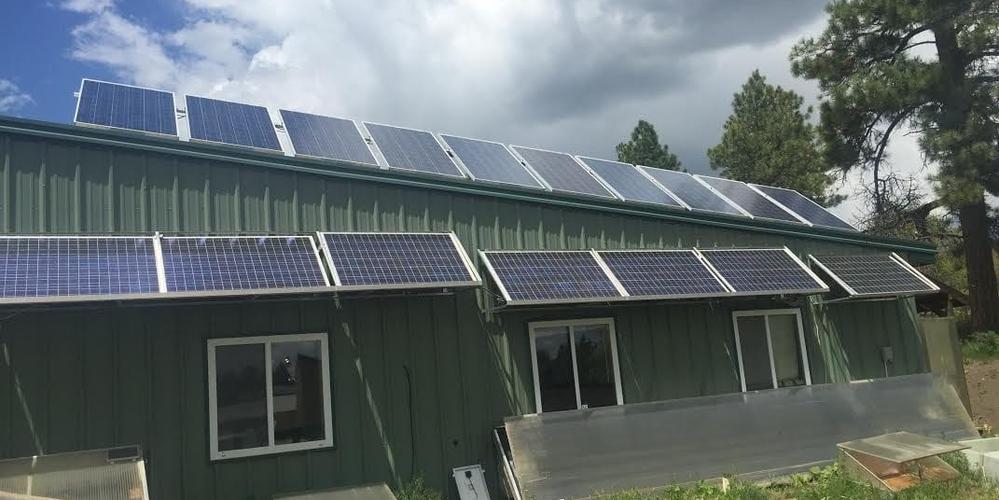
Solar Power, Your Pocketbook, and the Environment
Save Money, Combat Climate Change, and Power Ahead When the Rest of the World Grinds to a Halt
The electricity went out. The lights flickered overhead, the computer shouted a loud Kapoof! and turned off completely. I turned it back on, not thinking much of it. A little later the lights flickered and another Kapoof! from the computer. A quick glance out the window showed the electric company hoisting the boom on their truck.
I took it as a sign and an opportunity to take a break, get outside and fill the tank in the car, the one last drive before the car goes Kapoof! or – sspt sspt sputtering out of gas. So, off to the gas station. Why not? Car needs filled. I can’t work at the moment. One last turn of the engine left on the tank, so off to fill ‘er up.
At the gas station. No electricity. No electricity at the gas station means pumps won’t pump and no gas for me. It was half comical. One more turn of the engine left? I returned to Growing Spaces®, laughing at the folly, trying to keep it light.
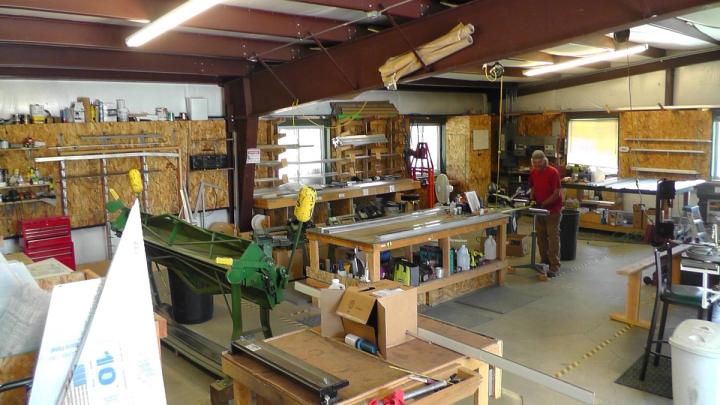
Speaking of light, the lights in “The Shop” had also turned off, but the crew on the production floor powered ahead without skipping a beat.*
So far, we have computer down, gas about gone, lines at the gas station, shop lights acting neurotic and there’s no electricity. However, the shop is in full production mode.
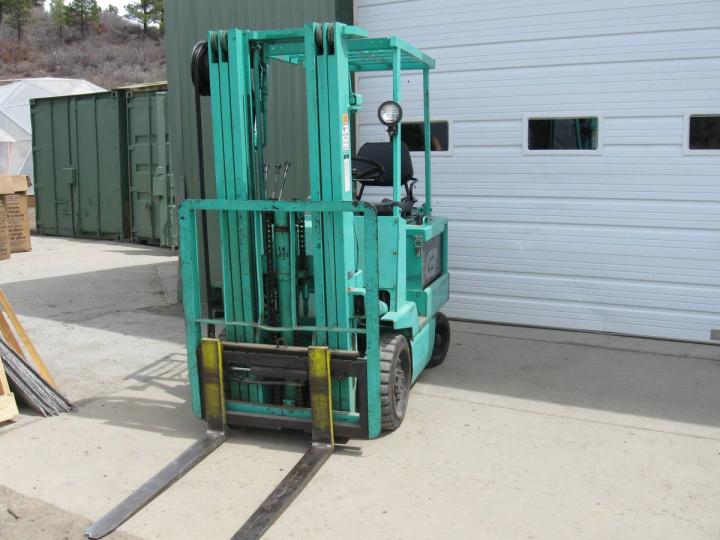
I can’t finish my post update, or fuel my vehicle, but the shop powers on like the Energizer Bunny. The rest of the world can halt to a stop, and the shop at Growing Spaces runs. The forklift, our green glory, charges on.
Saws continue spinning, drill presses bore through wood and aluminum, and a steady beat from the speakers creates that distinctive working environment of “The Shop.”
*Some shop workers were scratching their heads as to why the lights were out, but everything else kept running. The lights are intentionally tied to the grid so we know when something is amiss with the rest of the big world out there.
Here’s How
About twenty years ago, Udgar chose the path of self-reliance and opted out of the high cost to bring grid electricity to his home in Southwest Colorado. He went “off the grid” and powered his home with a stand-alone battery backup solar powered system.
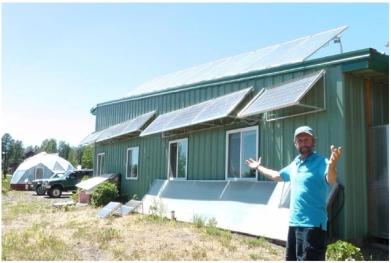
He still does. He likes it. And not surprising, when Growing Spaces grew into the need of a production facility, he installed a solar system to run “The Shop.” The first iteration involved a grid tied, stand-alone battery backup system. If the grid goes down, our production facility keeps running off the battery power. However, over time, Udgar installed a second system. It is also grid tied, but does not use batteries.
The solar panels in this system contain their own micro inverter on the back of the panel. The panel generates electricity and the micro inverter changes it from direct current (DC) to alternating current (AC) and the electricity is fed into the breaker and back into the grid.
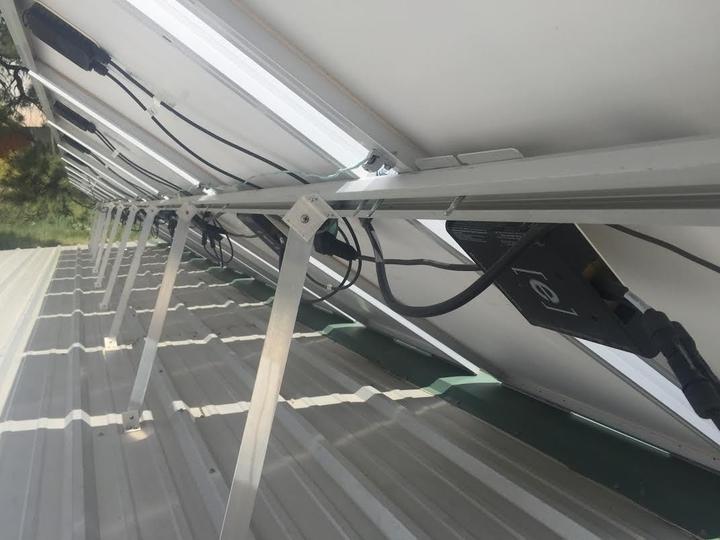
On sunny days, and on the weekends, our meter runs backwards. We generate electricity and pump it back into the grid and receive meter credit. At the end of the month, we pay our general fee for connection and maybe 5 to 7 dollars extra for electricity use. The entire Shop runs of solar power. We currently generate 90% – 95% of the electricity we use.
With conservation methods, such as turning off power strips and phantom loads, and generating our own electricity, we pretty much have free energy.
“I’d put my money on the sun and solar energy. What a source of power! I hope we don’t have to wait until oil and coal run out before we tackle that.” Thomas Edison, 1931
Solar Power Has Never Been Cheaper
Panels used to cost somewhere around $5 a watt. The cost has dropped significantly over the years. You can purchase panels today for as cheap as 50 cents a watt. That’s cheaper by a factor of ten. It is significant.
The affordability of solar panels means you recoup your costs of purchasing and installing a solar system in 4 – 5 years. After that: Free Electricity. Moreover, the panels and system will last up to 25 years.
Solar Power Means Self-Reliance and Free Energy
It’s Good for your Pocketbook and the Environment. If you have ever considered utilizing solar power, now is the time. Given the availability and low-cost of renewable solutions and solar panels, solar power is now cheaper than coal-fired electricity, or electricity generated by other fossil fuels.
“Renewables are really becoming cost-competitive, and they’re competing more directly with fossil fuels,” said BNEF analyst Luke Mills. “We’re seeing the utilization rate of fossil fuels wear away.” www.bloomberg.com
“Solar is cost effective right now. When you consider the cost to our health from air pollution, solar is just as competitive as any other energy source.” – Thomas P. Kay www.cleantechnica.com
Solar Power = Free Electricity
- Solar power is more affordable now than ever.
- Solar systems can last up to 25 years.
- A solar system can pay for itself in 4-5 years.
- Generating electricity with solar means less fossil fuel burned in coal-fired power plants.
- Solar energy fights climate change and unnecessary pollution. “Depending on where they are made, solar panels offset their carbon footprint in about four years.” www.greenpeace.org
- Experience the joy of independence and self-reliance.
When the grid goes down, when “the system” comes to a halt, but solar power keeps on going. Now, if the gas station would just install some solar power on their fuel pumps so my car could keep going.
Share This
For three days in March 2008 Jason Stuck shoveled gravel into a Growing Spaces’ 33’ Growing Dome. That was Jason's first “project” working for Growing Spaces. Jason easily fell in love with the product, the people, and the philosophy of helping the earth by helping others grow their own food. Jason wore many hats at Growing Spaces over the years. Shovel slinger, metal fabricator, shopkeeper and author. Jason wrote many articles for our website and newsletter.
Subscribe to Our Newsletter
Join our community to stay up to date

Featured Categories
Downloads

Please Subscribe to Our Newsletter! :-)
Please Join our community to stay up to date :-)